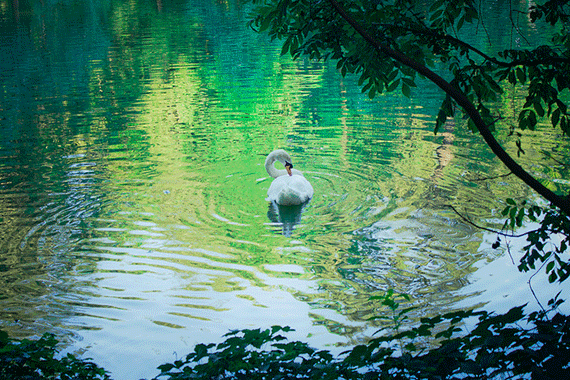Related reminder: only a few days left to get the Photography Action Cards at 88% Off
For beginners in photography, composition can be a real obstacle. Even when you have all the technical skills, it can be difficult to compose a photo that is pleasing to the eye. I have news for you: it is just as tough to teach to others. That’s because composition can be so personal. What appeals to me may not appeal to you.
However, many photographers, beginners in particular, are not happy with the way their photos look. But often they can’t quite put their finger on why.

Photo by Peter Liu Photography; ISO 100, f/16.0, 30-second exposure.
There are plenty of rules and guidelines to help you with composition. Possibly the best known is the rule of thirds. This rule suggests your composition should be divided into a nine-part grid, by running two lines horizontally (a third from the top and a third from the bottom) and two lines vertically (a third from the left and a third from the right). According to the rule, large objects (trees, buildings, etc.) should be placed on these lines, and small objects are most effective if positioned where the lines intersect.
Photos composed around these guidelines have a balanced look. Objects seem to appear exactly where your eye expects to find them. So when you build a composition around the rule of thirds, your photo satisfies the viewer’s natural sense of proportion.
Some people have an innate sense of visual balance. They have a natural flair for creative composition that does not need to be guided by rules. However, if you were to examine their photos, you would be sure to find that most of their photos fit the rule perfectly–even if they were not aware of it.

Photo by Rick Bergstrom; ISO 100, f/4.0, 1/640-second exposure.
The rule of thirds is an excellent place to start if you are a photographer struggling with composition. I recommend that every beginner learn it, practice it–get so familiar with it that you start to apply it without even thinking. Then, once you are truly comfortable with the rule of thirds, ignore it about half the time.
Recently a man walked into my gallery, and before I even said hello I heard him telling his friends: “You see, this is a good photo because it fits the rule of thirds. This is a bad photo because the kangaroo is right in the middle. This sunset is no good because the horizon is too low when it should be here, a third of the way up…”
This man was obviously an ardent devotee of the rule of thirds. For him, anything that stepped outside the boundaries of the rule was automatically a bad photo. But is composition really so simplistic? Of course not.

Photo by Ivana Vasilj; ISO 200, f/5.0, 1/60-second exposure.
The real world is not nearly so neatly organized as the rule of thirds. More importantly, being creative means finding your own way to express the character of a subject, which may not always require a traditional approach.
I can give you two very simple examples from my own collection. One of my outback photos has a very detailed foreground and some tall bushes in the background. I have positioned the horizon right through the center of the photo. If I raised it higher, I would have lost the foreground. If I dropped it lower, the tops of the bushes would be cut off. In this case, the composition was influenced by the circumstances.
The other example is a sunset photo. The sky in this photo is truly spectacular. I dropped the horizon very low so the colors of the sky fill the frame. If the horizon had been set a third of the way up, that would mean one third of the picture was black. Not only would this be wasted space that did nothing for the photo, it would also diminish the impact of the sky.

Photo by Anupam_ts; ISO 400, f/9.0, 1/125-second exposure.
Choosing to ignore the rule of thirds is not the same thing as not being aware of it. In each case, when taking a photo I would consider the rule of thirds and judge whether its application will make my picture better or worse. If I choose to ignore it, it is a deliberate method of adding impact to the composition, possibly by drawing attention to a particular feature like the sky in my sunset photo.
So, back to my earlier statement. If you are struggling with composition, the rule of thirds may be the best thing you ever learn. Not because you should use it for every photo (you shouldn’t) but because you should have the judgement to know when to use it and when to ignore it. That way, when you choose to compose your photo differently, it is not just a clumsy mistake, but a creative choice to improve the impact of the photo. Once you cross that threshold, your photography will become a true expression of your artistic eye.
About the Author:
Andrew Goodall writes for http://www.naturesimage.com.au and is a nature photographer based in Australia. He manages a gallery in Montville full of landscape photography from throughout Australia.
For Further Training, Deal Ending Soon:
Just recently released, The Photography Action Cards, 65 beautifully designed & printable project sheets that will give you over 200 photography assignments covering everything you can imagine. The response has been so big that we asked them to extend their launch sale just a little bit longer for our blog readers, currently 88% off today if you want to try them out.
Each card will retail for $ 5 USD. That means, buying the complete collection individually would cost hundreds. However, for this special early-access offer (to a very select few), you can grab this brand-new training tool for just $ 39! All of it also carries an amazing 365 day happiness guarantee so there is no risk in trying them.
Deal found here: The Photography Action Cards at 88% Off
Go to full article: Living With (and Without) the Rule of Thirds
What are your thoughts on this article? Join the discussion on Facebook
PictureCorrect subscribers can also learn more today with our #1 bestseller: The Photography Tutorial eBook
The post Living With (and Without) the Rule of Thirds appeared first on PictureCorrect.
